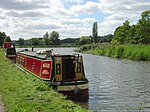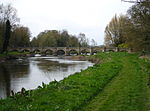Shugborough Tunnel

The Shugborough Tunnel is a 777-yard (710 m) railway tunnel on the Trent Valley line running under part of the Shugborough Estate in Colwich, Staffordshire, England. It was constructed in 1846 by the Trent Valley Railway (later the London and North Western Railway) and is located between Stafford station and Colwich Junction. Both portals, which were designed by John Livock, are grade II listed.The tunnel was built to hide the line at the insistence of Thomas Anson, 1st Earl of Lichfield, the landowner of the Shugborough Estate through which it passes, after negotiations with the railway company with options for diversion were also discussed. Shugborough Tunnel is the largest engineering work on the line.
Excerpt from the Wikipedia article Shugborough Tunnel (License: CC BY-SA 3.0, Authors, Images).Shugborough Tunnel
Oldhill Lane,
Geographical coordinates (GPS) Address Nearby Places Show on map
Geographical coordinates (GPS)
| Latitude | Longitude |
|---|---|
| N 52.792 ° | E -2.0292 ° |
Address
Oldhill Lane
Oldhill Lane
ST18 0XR
England, United Kingdom
Open on Google Maps








